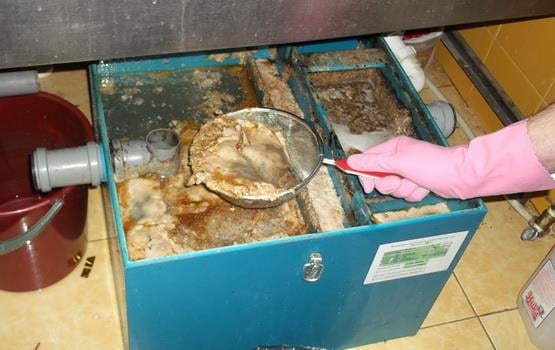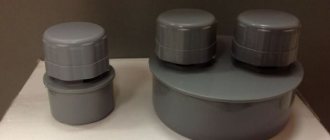Many housewives faced the problem of obstructed passage of drains and sewer pipes in the kitchen. This necessitates their constant cleaning of the sewage system. But it is often easier to prevent the problem than to fix it later.
Many blockages are caused by the accumulation of grease and the settling of oily liquids on the pipe walls. Therefore, installing a household grease trap under the sink is considered an effective means of creating comfort in the kitchen.

Purpose and design of the device
The grease trap is designed to prevent the penetration of fats and other oily substances into the sewage system or cleaning devices. Its action is based on the separation of water and fat. This is possible due to the differences in the specific gravity of these components.


Since fats and oily compounds are lighter than water, they end up on its surface. From there, they are redirected to a sump, which is regularly cleaned.
A household grease trap for a sink consists of the following components:
- compartment where heavier elements accumulate;
- compartment for fat and oil components;
- inlet tube;
- outlet tube for connection to the sewer system;
- cap.


Additionally, you can install a controller that monitors the level of accumulation of fat particles. If the compartment is overfilled, it must be cleaned mechanically.


To ensure the long-term operation of the device, fat-dissolving substances should be added to it.


What is the service
During operation, the grease trap must be periodically cleaned. The event is not pleasant, but it is easier than cleaning the sewer pipes from the accumulated grease plug. The regularity of cleaning works is determined by the following indicators:
• the temperature of the water used;
• tank capacity;
• the nature and composition of the effluent.
Depending on the factors listed and the separator model, service is performed at intervals of several weeks or several months.
It is necessary to carry out work with open windows in protective gloves (rubber) and a respirator. Safety measures are needed due to the presence of harmful bacteria in the tank, which are formed during the decomposition of fats.
After the installation of the installation, it is necessary to check the rate of accumulation of solid waste in the tank. Cleaning should be done when the fat mass reaches a level 3-4 cm above the lower edge of the discharge pipe. If this moment is missed and the fat is allowed to rise to the upper edge of the pipe, it will lead to the formation of a plug and flooding.
Cleaning activities also include rinsing the tank with hot water and detergents.
Advantages of grease trapping equipment
Such equipment has long been used at catering establishments. There it stably demonstrates its effectiveness.


Therefore, household models also began to be popularized, possessing the following advantages:
- simplicity of design and ease of installation;
- minimal maintenance with cleaning every 2 weeks;
- high efficiency, as a result of which the sewage system is almost completely freed from the ingress of fats into it, causing deposits on the walls;
- protection of the room from unpleasant odors;
- the tightness of the apparatus;
- long period of operation;
- no need for electricity and the use of chemical compounds for cleaning pipes;
- savings on the maintenance of the sewer infrastructure.


If you have a large home with many occupants, then more powerful protection may be required. You don't need to buy an industrial device. It is enough to place one more additional device under the sink. All the advantages of using can be seen in the photo of grease traps under the sink.
Calculation of performance
The efficiency of the simplest device is 25%, but you can make the device just as good. Indeed, according to reviews, the best household individual grease trap for each consumer will be exactly the one that is made with his own hands.
But before starting the production of a homemade fat trap from the sink, it is necessary to carry out a number of calculations. In order for a separator to do its job effectively, you need to determine the degree of load or capacity.
For industrial equipment, complex formulas are used that take into account various factors. For domestic needs, there is no need for these difficulties, and therefore you can use the formula P = n * Ps, where:
- P - productivity;
- n is the number of serviced car washes;
- Ps is the flow rate of water from the tap.
The Ps parameter is easy to determine. To do this, take a 1-liter jar, put it under the tap and open it with the pressure that is usually used (although it is better to increase it a little for safety reasons), and time the time.


Let it be 1 minute, then the value must be converted to l / s. Usually it is 0.1 l / s.
Plastic Models
These are the most popular and demanded models on the market. They are affordable and easy to use.


They are usually placed under the sink at home. The benefits include:
- long period of use, subject to the operating mode - up to 25-30 years;
- environmental friendliness of the material and harmlessness to humans;
- the possibility of individual selection of the size and shape of the separator;
- ease of maintenance.


With a wide variety of models in terms of power and throughput, plastic products are sensitive to mechanical damage.
Where can a fat separator be installed ↑
There are two options for installing grease traps - indoors or outdoors. Appliance manufacturers often choose a certain "specialization" and produce devices of the same type - for installation inside or outside the building.


Plastic grease separator
Indoor models ↑
Indoor models can be installed in the kitchen, in a separate room, or even in the basement. The location should be chosen based on considerations of ease of use and maintenance. The ideal option is to install a grease trap under the sink, but in some cases this is not possible.
The issue of fire safety also plays an important role in the choice of location. If it is impossible to mount the device at a sufficient distance from sources of open fire, it is better not to risk it.
Attention! Fat is highly flammable, burns for a long time and is difficult to extinguish. If the stove is too close to the sink, then it is better to install the grease trap in another room.


Cleaning the grease catcher
Features of the operation of street grease traps
Outdoor grease traps have a higher performance than those designed for installation under the sink. They are made of fiberglass or stainless steel and buried in the ground. Models of the STK series have proven themselves well.
The installation technology is quite simple, but it involves laborious work - digging a foundation pit, concreting, etc. Therefore, it is better to entrust the installation of a grease trap on the street to professional craftsmen. It is also worth taking care of additional devices that facilitate the operation of separators, for example, special sensors that monitor the level of deposits.
Note! Cleaning a street grease trap is a complicated procedure, and you often have to turn to sewage services for help. These are additional costs. They pay off by extending the time between cleanings.


Outdoor grease trap design
Fiberglass aggregates
This option is suitable for private houses where a high throughput of the grease purifier is important. This model can be installed both inside the house and outside.


Differs in higher strength, low weight, resistance to external influences and the influence of chemically active compounds. No effort required for installation or cleaning. At the same time, it is a more expensive model.


Helpful hints
Some helpful tips can help you to successfully assemble the unit:
For effectiveness, instead of glue, you can use a stronger fixing agent - epoxy and corners.
During the production of a household grease trap with your own hands, it is allowed to put partitions not strictly vertically, but also in a diagonal plane, using spacers (long bolts).
There is no need to center the inlets and outlets on the tank. Moving them slightly to the side will save space under the sink.
It is not always possible to make holes with a jigsaw, while avoiding the appearance of cracks. Therefore, it can be replaced with a children's wood burner.
As for ventilation, it can be omitted due to the slow fermentation reaction that takes place in the filter.


It should be noted that the filter will work effectively at a water temperature of no more than 40 ° C. If this is not enough for washing dishes and other needs, then the device should be installed as far as possible from the sink so that the water has time to cool down.






































































